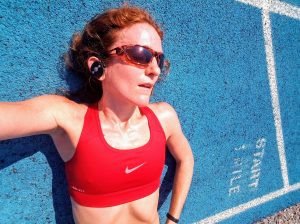This guest post was written by Runtastic
Almost every runner knows the importance of a warm up before a race. Even a marathon requires a warm up. But have you ever wondered why and, more importantly, how?
To help you understand why it is so important to warm up, we have put together a short list of the most important physiological effects of warming up.
Increased body temperature
By completing an active warm up before you begin the important part of your running (the race or workout itself), your body raises the temperature in your muscles, thus causing your body temperature to rise. This in turn speeds up your metabolic processes (which is especially important if you are trying to lose weight) and your energy supply.
Enhanced muscle performance
The increased muscle temperature lowers muscular resistance (viscosity). This allows your muscles to contract faster and stronger, which is important if you want to race well!
Increased cardio performance
Warming up also leads to increased cardiac output and a higher respiratory minute volume, which are needed for higher oxygen uptake.
Better joint load distribution
Another positive factor is that even short-term loads cause the cartilage layer in your joints to thicken, thereby widening the bearing surface and thus achieving a better distribution of loads.
Injury prevention
A number of research studies have shown that a proper warm-up can reduce the risk of injury.
Particularly in the case of fast and explosive muscular contractions and movements that require good flexibility like hill sprints or finishing a race with a kick.
Warmed-up body tissue has been shown to be more resilient. Warming up can also help prevent injuries by improving your attention and increasing your ability to react.
5 Tips to an Efficient Warm up
If you want to benefit from the positive effects of warming up, then we recommend following these 5 rules:
- Target the muscles that you will need for your race. A marathon will require a different warm up to a 5k or 10k.
- Finish your warm-up right as close to the start of the race as possible. The full effects do not last long after your warm-up. After 45 minutes of rest, your muscle temperature will return to normal. There will be no trace of the warm-up effect.
- The shorter and more intense the race is, the longer and more intense your warm-up routine needs to be. Make sure you are not falling for these 3 common myths of a warm up.
- Increase the intensity of your warm-up routine slowly and never start with jumping or sprinting exercises.
- The overall intensity of your warm-up should not exceed the anaerobic threshold.
The length and intensity of your warm-up routine is based on several factors.
You need to consider the length of the race, your physical condition, your age, as well as the time of day, and the weather conditions. Depending on these factors, your warm up should take between 10 and 45 minutes.
Unfortunately, there is no universal warm-up routine.
What the Warm-up Routine for Your Race Might Look Like
Start with the general part.
This consists of 10 to 20 minutes of jogging, followed by short dynamic stretching exercises. Afterwards, in the specific part, you should do some running drills .
For short or middle distance races, strides are particularly good for getting you ready to run at your race pace. These involve gradually accelerating your pace up to a submaximal sprint (approx. 90 % of your maximal sprint).
However, be careful not to warm up too much and tire yourself out, because this can hurt your race performance.
Different distances require different warm-up routines:
5k Race
A 5km race gets down to business right from the start.
You have to run at very high intensity, and your body must perform at 100% from the sound of the gun. This is why an extensive warm-up is essential for running a good race.
Start off by jogging at an intentionally easy pace for 10 to 15 minutes. This should be followed by several dynamic stretching exercises to increase your flexibility and mobilize your joints.
Dynamic stretching Routine (each exercise 3 to 5 times per side):
- Forward lunge: Stand with your legs hip-width apart, engage your core and keep your upper body straight. Step forward with your left leg, lowering your hips until both knees are are bent at a 90-degree angle. Make sure that your left knee does not extend beyond the tip of your left shoe. Return to the starting position and repeat on the other side.
- Lateral lunge (side lunge): The starting position is the same as for a forward lunge. Place your hands on your hips and take a big step to the side with your left leg. Keep your upper body straight and push your hips back. In the end position, your right leg should be almost straight and your left leg should be bent at a 90-degree angle. Make sure that your knee points forward and is not turned inward or to the outside. Plus, it is important that your bent knee not extend beyond the tip of your shoe. Return to the starting position and repeat on the other side.
- Star touch: Stand up straight with your feet wide apart, toes pointing forward. Keeping your legs as straight as possible, reach your left hand across your body and try to touch the toes of your right foot. Return to the starting position and repeat on the other side.
- Standing knee-to-chest stretch: Stand with your right foot slightly forward. Shift your weight to your right leg and bring your left leg forward. Lift your left knee up until you can hug your knee to your chest with both hands. Make sure to keep your upper body straight and your hips neutral. Return to the starting position and repeat on the other side.
The general part of the warm-up is followed by some running-specific exercises for better coordination and mobilization.
Running ABC drills:
Start the exercises from a slow jog (perform each exercise for approx. 5 seconds and repeat it 2 to 3 times):
- Butt kicks: Rapidly kick one heel up to your butt, alternating legs. Make sure to engage your core and keep your upper body straight. Try to keep your thighs perpendicular to the ground and swing your arms in sync with your legs.
- Skipping: Push off strongly with the ball of your foot and drive your knee upwards. Try to raise your knee waist high and be careful not to lean back. Your center of gravity should be slightly forward. Depending on how high you raise your knees, you can adjust the intensity of this exercise to suit your needs.
- Ankling: Lift off from your toes and raise your heel. Take a very short step, setting your toes down first. Make sure to extend your ankle as far as you can and try to minimize the time your foot spends on the ground. Throughout the exercise, keep your upper body straight and engage your core. Focus on swinging your arms in sync with your legs.
The final part of your warm-up is short, intense accelerations (or strides) to activate your muscles.
The accelerations should be really short because they are done at high intensity. If your accelerations are too long, or you do too many, this can quickly lead to fatigue which can diminsh your performance.
You also start these from a slow jog.
Gradually accelerate your pace up to a submaximal sprint (approx. 90 % of your maximal sprint) over a distance of about 60m. Do 3 or 4 accelerations. Jog for at least one minute after each acceleration.
Are All Warm Up Routines the Same?
Jogging, dynamic stretching and running ABC drills should be an integral part of your warm-up routine for races of all distances.
Accelerations are good for warming up for races up to a half marathon, but you should test them out in a tune up race to see if they are right for you.
The following list shows you how the warm-up procedure for a 5k race differs in terms of duration and intensity from those for longer races (10k, halfmarathon and marathon).
General part (jogging and dynamic stretching exercises):
- 5k: 15-20min
- 10k: 10 – 15 min
- Half marathon: 10 min
- Marathon: 5-10min
Specific exercises (running ABC drills and accelerations):
- 5k: 10min with 3–4 x 60m
- 10k: 5-10min with 2–3 x 60m
- Half marathon: 5min with 1-2 x 60m
- Marathon: 5min with 0-1 x 60m
Be careful in the last few minutes before the race that your muscles don’t get cold – keep moving around.
One final tip from Runtastic
You will know that you are properly warmed up when you break a sweat, depending on the air temperature, the humidity and the intensity of your warm-up.
What warm-up routines have you tried out? We would love to hear your experiences.
![]() Whether you’re looking to shed a few pounds, squeeze some exercise into your day or improve the quality of your sleep, you’re sure to find plenty of tips and tricks on the Runtastic blog! Runtastic’s content team is a high-powered mix of dietitians, certified personal trainers, running coaches and former professional athletes, all ready & eager to help boost your motivation and enhance your performance.
Whether you’re looking to shed a few pounds, squeeze some exercise into your day or improve the quality of your sleep, you’re sure to find plenty of tips and tricks on the Runtastic blog! Runtastic’s content team is a high-powered mix of dietitians, certified personal trainers, running coaches and former professional athletes, all ready & eager to help boost your motivation and enhance your performance.
Runtastic is a content partner of Runners Connect.





